-
I went to a hospital due to groin pain and was diagnosed with Osteoarthritis. What kind of disease is this?
-
Osteoarthritis is a disease in which the cartilage in the joints wears away with age and is very common in people after middle age. Osteoarthritis can also occur in the knees and fingers, but hip osteoarthritis occurs in the hip joint.
Osteoarthritis of the hip joint is a disease that causes pain, discomfort, twitching, and difficulty moving the hip joint as the cartilage wears away and the bone becomes deformed.
The hip joint is one of the joints most prone to osteoarthritis, second to the knee. Although worn joint cartilage was once thought to be the main cause, it is now believed to be related to inflammation of the entire joint.
Osteoarthritis is a disease that progresses gradually over time, so early effective treatment can avoid worsening of the disease.
-
What is the structure of the hip joint?
-
The hip joint is one of the largest joints in the human body. It is classified as a molar joint based on its shape, the consists of a ball called femoral head, and a socket called acetabular labrum into which the ball fits. The surfaces of the ball and socket are covered with cartilage. Articular cartilage is made of a very smooth-moving material (cartilage) that allows smooth bone-to-bone movement.
The surface of the hip joint has a thin layer of synovial membrane, which under normal conditions secretes a small amount of lubricating fluid called synovial fluid, which facilitates smooth joint movement.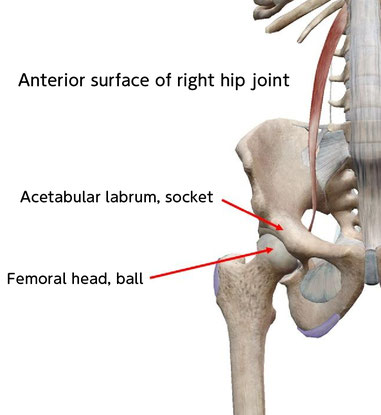
-
What are the symptoms of hip osteoarthritis?
-
The most common symptom of osteoarthritis is pain in the hip area.
The pain usually progresses slowly and worsens over time, but it can also develop suddenly. Pain can occur with daily activities such as tying shoelaces, getting up from a chair, or taking a short walk. Pain may also occur more frequently in more severe cases, such as pain turning over in bed at night or even at rest.
Other symptoms may include
- Groin or thigh pain that spreads to the buttocks or knees
- Stiffness and stiffness in the hip joint when getting out of bed or standing up after sitting in a chair for a long time
- Locked or immobilized joints, twitching sounds during joint movement (cartilage or other tissues impairing smooth movement)
- Narrowed range of motion of the hip joint, which can negatively affect the ability to walk and may cause a limp
- Increased joint pain in rainy weather
-
What are the causes of osteoarthritis of the hip joint?
-
There are two main causes of osteoarthritis. One is some structural abnormality, such as a congenital defect in the shape of the hip joint or an injury that causes damage, but the effect of such a structural abnormality over many years causes the joint to deform.
The other pattern of osteoarthritis is caused by constitutional problems such as obesity, age, menopause, and heredity. In this case, it often does not occur in only one joint, but other joints, such as knees and fingers, may also develop osteoarthritic changes.
The following factors increase the risk of developing the disease
- Aging
- Family history of osteoarthritis
- History of hip injury
- Obesity
- Dysplasia of the hip joint at birth, developmental abnormality of the hip joint, gender
- Postmenopausal
-
How is osteoarthritis of the hip diagnosed?
-
Osteoarthritis of the hip is first diagnosed based on an x-ray examination to determine the degree of cartilage wear and bone deformity, while referring to a history of the patient's past medical history and a physical examination, including an examination of the range of motion of the hip joint and posture that causes pain. X-rays are also useful in following the course of the disease. In addition to bone abnormalities, MRI scans can evaluate cartilage thinning, abnormalities in the bone marrow, the degree of fluid buildup in the joint called edema, and the condition of the ligaments and muscles surrounding the joint.
-
How does osteoarthritis progress?
-
Osteoarthritis progresses as follows.
First, the synovial membrane, which surrounds the joint, becomes inflamed. Inflammation can be caused by a variety of factors, including structural abnormalities such as those mentioned above and physical constitutional changes.
Inflammatory substances are then released from the synovial membrane, and water accumulates in the joint. At this time, a little pain may occur and may progress unnoticed. The bones are not yet deformed, and x-rays show no abnormalities.
Next, the cartilage covering the surface of the bone gradually wears away as this waterlogged inflammatory condition continues for a long time (years). As the cartilage wears away, force is exerted on the bone beneath the cartilage (subchondral bone), which would not normally be in contact with the cartilage, and a cyst, which looks like a water bag, or a bony prominence, called an osteophyte, may form in this bone. At this stage, the deformity can be clearly seen on x-rays.
In addition, the deformation of the ligaments and joint capsule tissues that surround the joints causes additional stress, resulting in further inflammation. This highly deformed condition results in constant inflammation and pain that always interferes with daily life.
-
I went to the hospital because of pain in my hip joint and was told that it did not look so bad on x-ray, but the base of my leg is very painful. What is going on?
-
Bone deformity on x-ray examination does not necessarily correspond to the intensity of hip pain. In other words, some people have strong pain even though they are not that deformed on x-ray, while others have no pain even though they are deformed to a certain degree on x-ray.
In fact, osteoarthritis pain is not only caused by bone deformity. Bone deformity can cause pain when it becomes quite severe (severe deformity), but it is not the cause of pain at the stage before it becomes severe. So, the question is what causes pain other than bone deformity?
One cause is inflammation. Inflammation around the hip joint can cause pain. In addition, it has recently been found that many abnormal problematic blood vessels have formed in such inflammation, and that the nerves also increase around these vessels together, causing pain that is difficult to heal.
-
I have been diagnosed with hip osteoarthritis. Is there anything I should not do?
-
Standing for a long period of time and squatting deeply can put a lot of strain on your hip joint.
When you are at home, try to avoid sitting on the floor and use a chair to reduce the chance of bending the hip joint deeply and it will reduce the strain. Refrain from working in a low posture for long time such as dusting the floor or pulling weeds.
Also, when you walk, it is better not to carry a heavy load on one side of the body. It puts a lot of strain on the hip joint, so avoiding these activities will reduce the strain. Do not walk for a long time when the pain is strong and take some breaks. We recommend not to stay (stand) in a cold place as it puts a stain on your hip joint as well.
In terms of exercise, try to avoid golf and running, as they are very hard on the hip joint. Instead, yoga, cycling and swimming are less stressful.
-
Sometimes when it is cold or rainy, my hip joint hurts and I cannot walk. Is there a relationship between weather and pain?
-
There is a strong relationship between weather conditions such as cold or rainy and hip pain.
The biggest relationship is that rainy or cold weather is often associated with low air pressure, and these low air pressure increase the pain on hip joint.
This is because, as mentioned earlier, blood vessels and nerves increase together in the painful hip joint, and these blood vessels dilate when the air pressure is low, which stimulates the nearby nerves and increases the pain.
(There is less air pressure than usual, and the blood vessels throughout the body dilate slightly on low pressure days. When this happens, the nerves right next to the blood vessels are stimulated and the pain increases. This is the same principle that causes headache on low pressure days.)Another reason is that human body is known to be hypersensitive to various stimuli when the temperature is low. This is because the human body’s descending inhibitory system, which weakens pain signals, is weakened in cold weather.
For the above reasons, rainy or cold weather can increase hip joint pain. If you want to know more, consider seeing a medical professional who specializes in chronic pain.
-
I was diagnosed with a hip labrum injury and have been treated with rehabilitation and injections, but the pain is not going away. I have been advised to have a surgery, but is there any way other than surgery to improve the pain?
-
Artificial joint surgery is heavy burden on your body, so you need to be careful to decide whether you take it or not. As an alternative to surgery, “multidisciplinary treatment,” which is a combination of various treatments, is effective.
Multidisciplinary treatment is the combination of several “non-surgical methods” to relive hip joint pain. For instance, there is catheterization to reduce abnormal problematic blood vessels around the hip joint.
This is a treatment to remove pain with as little surgery as possible by combining such out-patient treatments, adding medication to strengthen bones, reviewing lifestyle to produce more serotonin in the brain, and actively managing diet to lose weight.
-
I was diagnosed with hip osteoarthritis. What will be done in rehabilitation
-
The physiotherapist will evaluate your current pain, range of joint motion, and muscle strength around the hip joint as well as daily activities or hobbies, and then plan to meet your individual goals and process with rehabilitation.
The rehabilitation includes exercises to increase the range of joint motion, strength training, balance exercises in sitting and standing positions, and exercises for daily life and sports activities.
-
Are there any effective stretches for osteoarthritis of hip?
-
The hip joint can move in a variety of directions, but the direction of motion that can become particularly stiff with osteoarthritis is flexion and external rotation. Stretching in these directions can be helpful in improving osteoarthritis. It is also important to stretch trunk of the body to improve osteoarthritis. The following are some stretches for each area.
■Flexion Stretch
- Lie on your back
- Bend one knee and hold it with your hands
- Then pull the knee toward your face. Be careful not to float the other leg. If you feel strong pain, do not strain yourself.
If you can do this without pain, stretch for 30 seconds with slow breath.
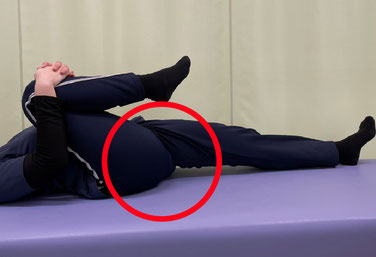
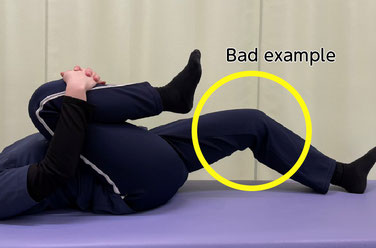
Make sure that the other knee does not float
■External Rotation Stretch
- Lie on your back
- Bend one knee 90 degrees and roll it outward. Do this as far as possible without straining or feeling pain.
Be careful not to lift the other hip. Breathe slowly and stretch for 30 seconds.
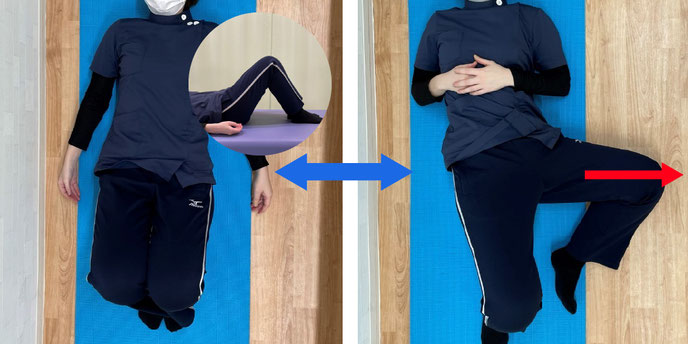
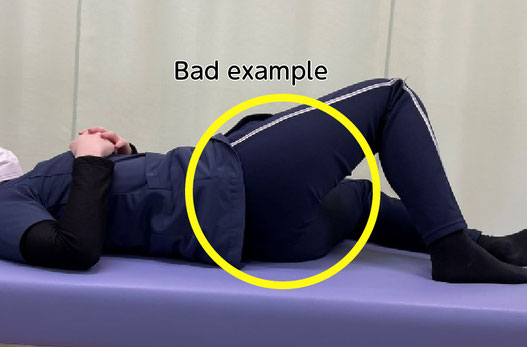
■Core Stretch
- Sit on a chair
- Round your back as if your belly is pulled back
- Bring your belly forward and stretch your back
- Repeat 2&3 about 10 times slowly
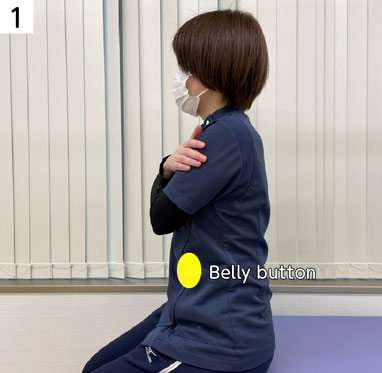
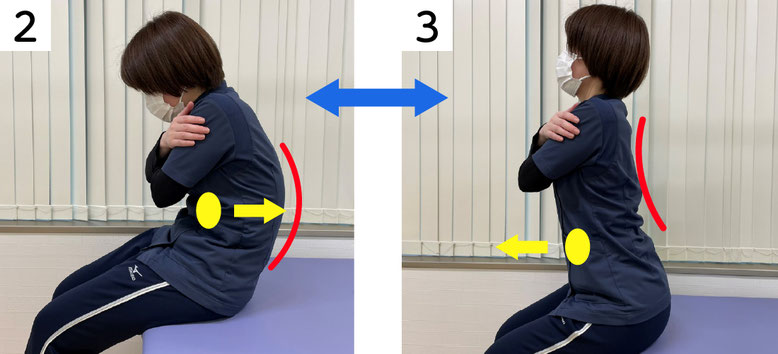
-
Is there an effective weight training for hip osteoarthritis?
-
In addition to stretching, weight training is effective as a do-it-yourself remedy for osteoarthritis. It is especially important to stimulate the muscles that control the movement of the spine. Please try the following methods.
■Training
- Get down on all fours.
- Slowly raise one leg off the ground and extend it behind you. Stretch the knee so that the leg is in a straight line with the torso.
- After 5 seconds, lower the leg and return to all fours, then raise the opposite leg in the same manner for 5 seconds.
- 10 times on each side.
Do not try this on a hard floor, as it may cause pain in the kneecaps.
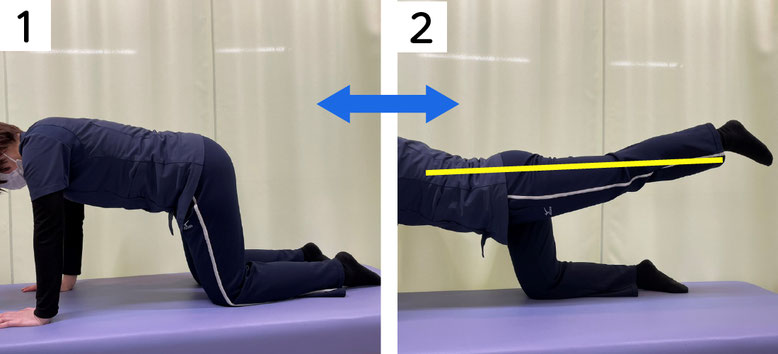
-
As conservative treatment for osteoarthritis of the hip, should rehabilitation and exercise therapy be continued even if it is painful?
-
If the pain remains until the next day after rehabilitation or exercise therapy, the intensity is too strong and should be reduced or stopped. Walking or jogging as exercise therapy is hard on the hip joint. They should be replaced with activities that are less stressful on the hip joint, such as cycling or swimming.
-
What are some non-surgical treatments for hip osteoarthritis?
-
In case of hip osteoarthritis, unfortunately there is no treatment to reverse the deformed bone, but there are several treatments that can help relieve pain and improve mobility.
Conservative (nonsurgical) treatments include:
- Lifestyle modification and weight loss
- Physical therapy
- Assistive devices: canes, walkers etc.
- Medications (Loxonin, Acetaminophen, Tramadol, etc.)
- Injection therapy (Hyaluronic acid, Steroids, etc.)
In addition, there is a newer conservative therapy called catheterization procedure, which is used to reduce the number of extra problem blood vessels around the hip joint.
-
What are the surgical options for osteoarthritis of the hip?
-
Surgery may be recommended when conservative treatment fails to improve the patient's condition.
- Hip Replacement: In this hip replacement surgery, the damaged bone and cartilage of the acetabulum (hip socket) are removed and replaced with a metal shell. However, the femoral head is not removed and is covered with smooth metal.
- Total Hip Replacement (THR): Both the damaged acetabulum and femoral head are removed, and a new metal, plastic or ceramic joint surface is fitted to restore hip function.
The time to return to work and rehabilitation following surgery for osteoarthritis of the hip depends on the type of surgery performed. Physical therapy is commonly used to regain strength and range of motion in the hip joint. Following surgery, crutches or a mobility aid may be used for some time. It is recommended that you ask your doctor for more information on how to proceed after these surgeries.
Author

-
-Dr. Yuji Okuno-
ฉันเริ่มต้นอาชีพในฐานะแพทย์รังสีวิทยาทางการแทรกแซง ซึ่งนำไปสู่การวิจัยเกี่ยวกับการสร้างหลอดเลือดผิดปกติในระหว่างการศึกษาปริญญาโท ในฐานะผู้เขียนหลัก ฉันได้เผยแพร่ผลการศึกษาที่เกี่ยวข้องกับยีนที่เกี่ยวข้องในวารสาร Nature Medicine ในปี 2012 จากงานวิจัยนี้ ฉันได้พัฒนาการรักษาด้วยการอุดหลอดเลือดแบบใหม่สำหรับโรคทางกล้ามเนื้อและกระดูกเรื้อรัง เช่น ข้อเข่าเสื่อมและไหล่แข็ง และเป็นคนแรกที่รายงานถึงความปลอดภัยและประสิทธิภาพของมัน แนวทางนี้กำลังได้รับการศึกษาระดับนานาชาติ
-Career-
2549-2552 นักศึกษาฝึกงาน, ภาควิชารังสีวิทยา, คลินิกา ET, โยโกฮาม่า, ญี่ปุ่น
2552-2555 นักวิจัย, ศูนย์วิจัยการแพทย์แบบบูรณาการ, มหาวิทยาลัยเคโอ, โตเกียว, ญี่ปุ่น
2555-2558 นักวิจัยคลินิก, ภาควิชารังสีวิทยาทางการแทรกแซง, โรงพยาบาลเอดะโงะ, โตเกียว, ญี่ปุ่น
2558-2560 ผู้อำนวยการ, ศูนย์แทรกแซงทางกระดูกและข้อ, โรงพยาบาลเอดะโงะ, โตเกียว, ญี่ปุ่น
2560- ปัจจุบัน ผู้อำนวยการสูงสุด, คลินิกโอกุโนะ, โตเกียว, ญี่ปุ่น
Latest posts
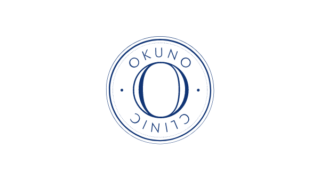 Sep 12, 2025โรคเกาต์ FAQ
Sep 12, 2025โรคเกาต์ FAQ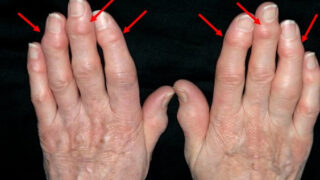 Sep 12, 2025Heberdens Nodes FAQ
Sep 12, 2025Heberdens Nodes FAQ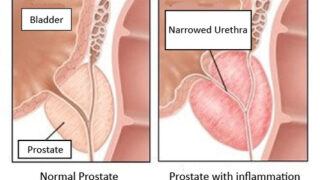 Feb 7, 2025Chronic prostatitis โรคต่อมลูกหมากอักเสบ
Feb 7, 2025Chronic prostatitis โรคต่อมลูกหมากอักเสบ Feb 7, 2025Frozen shoulder โรคไหล่ติด
Feb 7, 2025Frozen shoulder โรคไหล่ติด